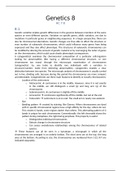Genetics 8
HC 7-8
8.1
Genetic variation implies genetic differences in the genome between members of the same
species or even different species. Variation on specific genes, allelic variation, are due to
mutations in particular genes or neighbouring sequences. In a larger perspective, there can
also be chromosomal aberrations. Genetic changes are thus able to affect the structure or
even number of eukaryotic chromosomes, which could influence many genes from being
expressed and thus also affect phenotype. The structures of eukaryotic chromosomes can
be modified by altering the amount of genetic material or by rearranging the order of genes
on the chromosomes, which could cause drastic phenotypic consequences.
A cytogeneticist examines the chromosomal composition of a particular cell/organism
looking for abnormalities (like having a different chromosomal structure, or one
chromosome too many) through the microscopic examination of chromosomes
(cytogenetics). So, one looks to identify rare individuals with a variation in
structure/number. Aside from detecting abnormalities, cytogenetics enables a clear
distinction between two species. The microscopic analysis of chromosomes is usually carried
out in live, dividing cells, because during this period the chromosomes are more compact
and detectable. Cytogeneticists use three main features to identify or classify chromosomes:
- Location of the centromere
o Metacentric centromere is in the middle. However, since it is not exactly
in the middle, we still distinguish a small (p) and long arm (q) of the
chromosome.
o Submetacentric centromere is slightly off the middle
o Acrocentric centromere significantly off the middle, but not at the end
o Telocentric centromere is at on end. The small arm is nearly non-existent.
- Size
- Banding pattern created by staining, like Giemsa. When chromosomes are dyed
with it, specific chromosomal regions have a high affinity for the dye, others do not.
This creates G bands, some regions darker than others. This alternating pattern of G
bands is unique for each chromosome. Conventionally, the left chromatid shows the
pattern during metaphase, the right during prophase. This property is useful:
o Distinguishes individual chromosomes
o Detects change in chromosome structure
o Can assess evolutionary relationships among the chromosomes of related
species.
These features can all be seen in a karyotype, a micrograph in which all the
chromosomes are arranged in an orderly fashion. The short arms are at the top, the long
ones at the bottom. According to size, the chromosomes are numbered from 1-22; X/Y are
indicated separately.
, 8.2
The structures of normal chromosomes can be modified by mutation. This can either
change the total amount of genetic material or keep the same amount, but rearrange it:
- Total amount of genetic material in the chromosome can change:
o Deletions: a segment of chromosomal material is missing, deleted, so the
chromosome is deficient in significant amount of genetic material.
o Duplications: a section of a chromosome is repeated more than once within a
chromosome.
- Chromosomal rearrangements, amount of genetic material remains static:
o Inversion: a change in the direction of the genetic material along a single
chromosome.
o Translocation: one segment of a chromosome becomes attached to another,
different (part of a) chromosome.
Simple translocation: a single piece of a chromosome is attached to
another chromosome, one-way transfer
Reciprocal translocation: two different chromosome exchange pieces,
so both are structurally altered, two-way transfer.
8.3
A chromosomal deletion/deficiency occurs when a chromosome breaks in one or more
places and a fragment is lost. A piece that breaks off at the end following a single break is
left without centromere and thus has difficulty finding its way into the nucleus following
mitosis, where after it is degraded; terminal deletion. If there are two breaks, there are
three fragments and the central one will be lost, since the outer ones manage to reattach to
each other; interstitial deletion. Moreover, deletions can also take place when
recombination occurs in the wrong location. Phenotypic consequences depend on the size
of the deletion and whether or not vital genes for proper development are lost
(chromosomal material deleted); if they indeed have a phenotypic effect, the deletion is
detrimental. This is mostly the case with large deletions, because the chance important
genes will be lost is higher then.
Duplications in general are less harmful than deletions. They appear due to abnormalities in
crossing over; during meiosis homologous chromosomes align and recombine their genetic
material. If, for some reason, the alignment is off, the crossover causes duplications and
deletions. Such a misalignment could occur when two repetitive sequences are believed to
be alike, but they are actually not on the same part of the chromosome; nonallelic
homologous recombination occurred at homologous sites, but not with alleles of the
same gene. One chromosome would then have a duplication, two of the same genes, whilst
the other would miss one, a deletion. The same accounts for duplications, the phenotypic
consequence depends on the size of the duplication.
The majority of small gene duplications have no phenotypic effect; having more of a gene is
better than having one too less. Duplications can form gene families; a gene has two copies
of itself, two or more genes that are similar to each other which form a family. But over time
the two copies can accumulate different mutations and so the two genes can differ a bit.
Nevertheless, they remain similar, only not identical with distinct functions, but still add to
the gene family. Two or more genes that are derived from a single ancestor are
homologous, and if these homologous genes are within a single species, they are paralogs,





